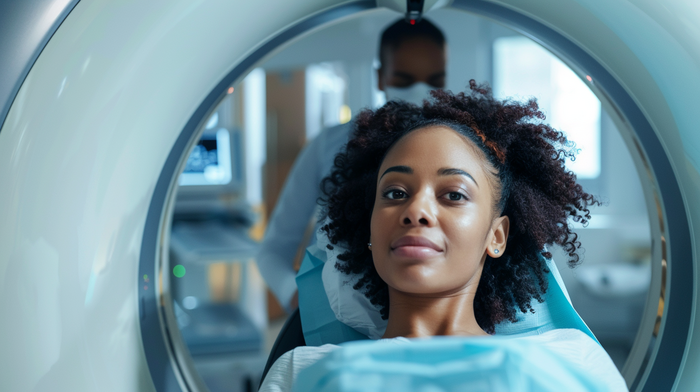
Feel better faster. Get care today.
From the clinic or your couch. Find high quality, same-day urgent care for you and your kids. Book an urgent care visit today.

MRIs (magnetic resonance imaging) are among the most popular and effective medical imaging tests, according to RadiologyInfo.org. MRI scans provide detailed images of your internal organs and are used to diagnose many abnormalities and monitor treatments.
Like many laboratory and imaging tests, finding out you need an MRI can be nerve-wracking. One thing that could help you calm your nerves is understanding what an MRI is, how it works, how to prepare for it, and what to expect when you’re getting it done.
“MRI” stands for magnetic resonance imaging—an imaging test that uses radio waves and powerful magnets to view organs, bones, and other tissues inside your body. According to the Radiological Society of North America, an MRI can give a doctor important information about different parts of your body without having to perform an invasive procedure.
X-rays, ultrasounds, and CT scans are other common ways to view the inside of your body, according to the Radiological Society of North America. But each of these has its pros and cons—and each of these is better at seeing certain things than others. For example, X-rays are great for viewing bones but usually don’t give a good view of soft tissues which are better viewed on ultrasound. Since MRIs don’t use ionizing radiation, they are a safer and more sustainable way to diagnose and treat ailments, according to RadiologyInfo.org.
The Radiological Society of North America lists several reasons why you might need to get an MRI scan, including the following:
MRIs can be used to see the brain and spinal cord, which can diagnose:
MRIs can also focus on the heart and blood vessels, which can help doctors diagnose:
MRIs can also identify tumors and irregularities in many other body organs and structures, including:
MRIs are usually done by an MRI technologist and read by a radiologist (a medical doctor who specializes in reading imaging), according to the Radiological Society of North America..

From the clinic or your couch. Find high quality, same-day urgent care for you and your kids. Book an urgent care visit today.
One of the most stressful things about getting an MRI is not knowing what to expect. For people who don’t like enclosed spaces, having an MRI can cause additional anxiety. Thankfully there are ways you can minimize your anxiety. Here are the most important things to do when you’re preparing for an MRI:
An MRI machine looks like a large doughnut. During your MRI scan, you will be lying on a bed inside the tube portion of the machine. For someone with claustrophobia, this might sound like a nightmare. There are ways you can calm your anxiety though. Understand that an open MRI is open on both ends, so you will not be fully closed in. Additionally, your doctor can prescribe medication that will help you feel relaxed during your MRI. It is important to be open and honest about your claustrophobia before the date of your MRI, so you have plenty of time to make a plan and fill a prescription if needed.
Because an MRI machine uses magnetic energy to take scans of your body, you should not wear any metal—including underwire bras and jewelry. For those who have expensive jewelry, leaving it at home is the best way to go.
Certain conditions may require changing how your MRI procedure is done (and maybe even delaying it, if possible). RadiologyInfo.org lists the following as some specific concerns to be aware of:
Make sure you are open and honest with your doctor about your health history, including any past health history. According to the Radiological Society of North America, you can eat and drink normally, as well as take your normal medications before your MRI (unless your doctor tells you otherwise).
While everyone’s experience may be slightly different, there are a few things you can count on when it comes to your MRI scan.
After your MRI scan, RadiologyInfo.org notes that you can put your jewelry back in and return to normal activities unless directed otherwise by your doctor. If you received contrast dye as part of your MRI, Health Images notes that you should monitor yourself for signs of an allergic reaction, which include:
If you’re having pain or discomfort, you may need an MRI scan. Since a doctor’s order is needed to get an MRI scan, you’ll want to start by making an appointment with a physician. Urgent care is often the fastest way to see a doctor. Find and schedule an appointment at an urgent care clinic near you, using Solv.
An MRI (Magnetic Resonance Imaging) is a medical imaging test that uses radio waves and powerful magnets to provide detailed images of internal organs, bones, and tissues.
MRI scans can diagnose and monitor many conditions including aneurysms, multiple sclerosis, tumors, heart disease, and abnormalities in various internal organs.
You should let your doctor know if you have claustrophobia, leave any metal items like jewelry at home, and be honest about your health history.
You can expect noise, the need to lie still for several minutes, a potentially long duration of lying down, and possibly receiving a contrast dye.
You can return to normal activities unless instructed otherwise by your doctor. If you received contrast dye, you should monitor for signs of an allergic reaction.